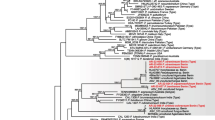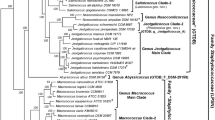Abstract
Amomum Semen, the seed mass of Amomum xanthioides, has been imported from Southeast Asia and China and used for the treatment of gastric and intestinal disorders. A. xanthioides has been treated as a synonym of A. villosum var. xanthioides. Furthermore, A. villosum var. villosum, A. villosum var. xanthioides, or A. longiligulare have been described as the botanical origin of Amomi Fructus, which is a similar crude drug in Chinese Pharmacopoeia. Under these circumstances, the botanical origin of Amomum Semen was changed to A. villosum var. xanthioides, A. villosum var. villosum, or A. longiligulare in Supplement II to the 17th edition of the Japanese Pharmacopoeia. To develop an objective identification method for Amomum Semen and to confirm the phylogenetic relationship among Amomum taxa, the nucleotide sequences of the nuclear ribosomal DNA internal transcribed spacer region and chloroplast DNA partial matK-trnK and trnH-psbA intergenic spacer regions were determined in specimens collected from Southeast Asia and China, including those from the type localities of each taxon. Six taxa were divided into four groups. A. xanthioides from Myanmar belonging to group 1 was discriminated from A. villosum var. xanthioides from China of group 2. A. villosum and its varieties were divided into two groups: group 2 included those from China, and group 3 consisted of A. villosum from Laos. A. longiligulare from China and Laos and A. uliginosum from Laos belonged to group 3 and group 4, respectively. These findings illustrate the phylogenetic basis for the need for taxonomical reorganization among the Amomum species.

Similar content being viewed by others
References
The State Pharmacopoeia Commission of China (2020) Pharmacopoeia of People’s Republic of China, vol 1. The Chemical Industry Press, Beijing (in Chinese)
Wu TL, Chen SJ (1978) Materials for Chinese Zingiberaceae. Acta Phytotax Sin 16(3):25–46
IPNI (2020) International Plant Names Index. Published on the Internet http://www.ipni.org, The Royal Botanic Gardens, Kew, Harvard University Herbaria & Libraries and Australian National Botanic Gardens. Accessed 12 October 2020
The Ministry of Health, Labour, and Welfare (2019) Supplement II to The Japanese Pharmacopoeia 17th edition (English version). The MHLW Ministerial Notification No. 64, Tokyo
Baker JG (1892) Amomum. In: Hooker JD. (ed.) Flora of British India 6:233–243
Loureiro J (1790) Flora Cochinchinensis Lisbon
Newman MF, Lamxay V (2011) (2006) Proposal to conserve the name Amomum villosum (Zingiberaceae) with a conserved type. Taxon 60(2):596–598. https://doi.org/10.1002/tax.602037
Wu TL, Larsen K (2000) Amomum. In: Wu ZY, Raven PH (eds) Flora of China. Vol. 24 (Flagallariaceae through Marantaceae). Science Press, Beijing; Missouri Botanical Garden Press, St. Louis, pp 347–356
Wu TL (1977) Flora of Hainanica 4:533
Pharmaceutical and Medical Device Regulatory Science Society of Japan (2016) “The Japanese Pharmacopoeia Technical Information 2016”, Jiho, Inc., p 1228
Yamamoto Y, Ko H, Sasaki H, Takeda O, Higuchi Y, Mukaida Y, Mori Y, Yamaguchi Y, Shiratori M (2019) Survey on crude drug usage in Japan. Shoyakugaku Zasshi 73(1):16–35. https://doi.org/10.24684/jspharm.73.1_16
Hao JD, Mei QX, Yang H (2011) Zhong hua ren min gong he guo yao dian bu zhu shuo ming 2010 nian ban yi bu (yao cai ji yin pian). Zhong guo zhong yi yao chu ban she pp 400–403 (in Chinese)
Lamxay V, Newman MF (2012) A revision of Amomum (Zingiberaceae) in Cambodia Laos and Vietnam. Edinburgh J Bot 69(1):99–206. https://doi.org/10.1017/S0960428611000436
Pan H, Huang F, Wang P, Zhou L, Cao L, Liang R (2001) Identification of Amomum villosum, Amomum villosum var. xanthioides and Amomum longiligulare on ITS-1 sequence. J Chinese Med Mater 24(7):481–483
Zhou L, Wang P, Huang F, Cao LY, Liang RY (2002) ITS sequence analysis of Amomum villosum. Chinese Trad Herbal Drugs 33(1):72–75
Jiao W, Zhang P, Liao B, Wang L, Han J (2014) A rapid SNP-based identification method for distinguishing the three origins of Fructus Amomi. World Sci Technol Modern Trad Chinese Med Mater Medica 16(2):295–300
Doh EJ, Kim JH, Lee G (2019) Identification and monitoring of Amomi Fructus and its adulterants based on DNA barcoding analysis and designed DNA markers. Molecules 24:4193. https://doi.org/10.3390/molecules24224193
Huang Q, Duan Z, Yang J, Ma X, Zhan R, Xu H, Chen W (2014) SNP typing for germplasm identification of Amomum villosum Lour. based on DNA barcoding markers. PLoS ONE 9(12):e1114940. https://doi.org/10.1371/journal.pone.0114940
de Boer H, Newman M, Poulsen AD, Droop AJ, Feìr T, Hiên LTT, Hlavataì K, Lamxay V, Richardson JE, Steffen K, Leong-Škorničkova J (2018) Convergent morphology in Alpinieae (Zingiberaceae): Recircumscribing Amomum as a monophyletic genus. Taxon 67(1):6–36. https://doi.org/10.12705/671.2
White TJ, Bruns T, Lee S, Taylor J (1990) Amplification and direct sequencing of fungal ribosomal RNA genes for phylogenetics. In: Innis MA, Gelfand DH, Sninsky JJ, White TJ (eds) PCR protocols, a guide to methods and applications. Academic Press, San Diego, pp 315–322
Fan LL, Zhu S, Chen HB, Yang DH, Cai SQ, Komatsu K (2009) Molecular analysis of Stemona plants in China based on sequences of four chloroplast DNA regions. Biol Pharm Bull 32(8):1439–1446. https://doi.org/10.1248/bpb.32.1439
Kelly PS, Rytas V (1994) Phylogenetic analyses of polemoniaceae using nucleotide sequences of the plastid gene matK. Syst Bot 19(1):126–142. https://doi.org/10.2307/2419717
Kress WJ, Prince LM, Williams KJ (2002) The phylogeny and a new classification of the Gingers (Zingiberaceae): Evidence from molecular data. Amer J Bot 89(11):1682–1696. https://doi.org/10.3732/ajb.89.10.1682
Xia YM, Kress WJ, Prince LM (2004) Phylogenetic analyses of Amomum (Alpinioideae: Zingiberaceae) using ITS and matK DNA sequence data. Syst Bot 29(2):334–344. https://doi.org/10.1600/036364404774195520
Takaiwa F, Oono K, Sugiura M (1985) Nucleotide sequence of the 17S–25S spacer region from rice rDNA. Plant Mol Biol 4:355–364. https://doi.org/10.1007/BF02418257
Cui Y, Chen X, Nie L, Sun W, Hu H, Lin Y, Li H, Zheng X, Song J, Yao H (2019) Comparison and phylogenetic analysis of chloroplast genomes of three medicinal and edible Amomum species. Int J Mol Sci 20:4040. https://doi.org/10.3390/ijms20164040
Tamura K (1992) Estimation of the number of nucleotide substitutions when there are strong transition-transversion and G + C-content biases. Mol Biol Evol 9:678–687. https://doi.org/10.1093/oxfordjournals.molbev.a040752
Kumar S, Stecher G, Li M, Knyaz C, Tamura K (2018) MEGA X: Molecular evolutionary genetics analysis across computing platforms. Mol Biol Evol 35:1547–1549. https://doi.org/10.1093/molbev/msy096
Felsenstein J (1985) Confidence limits on phylogenies: An approach using the bootstrap. Evolution 39:783–791. https://doi.org/10.2307/2408678
Acknowledgements
This work was supported in part by JSPS KAKENHI Grant Numbers 15H05268, and by the Research on Development of New Drugs from Japan Agency for Medical Research and Development, AMED [Grant number JP20ak0101046], as well as a research grant from Tsumura & Co.
Author information
Authors and Affiliations
Corresponding author
Ethics declarations
Conflict of interest
Dr. Katsuko Komatsu received a research grant from Tsumura & Co.
Additional information
Publisher's Note
Springer Nature remains neutral with regard to jurisdictional claims in published maps and institutional affiliations.
Supplementary Information
Below is the link to the electronic supplementary material.
Rights and permissions
About this article
Cite this article
Sone, M., Zhu, S., Cheng, X. et al. Genetic diversity of Amomum xanthioides and its related species from Southeast Asia and China. J Nat Med 75, 798–812 (2021). https://doi.org/10.1007/s11418-021-01512-2
Received:
Accepted:
Published:
Issue Date:
DOI: https://doi.org/10.1007/s11418-021-01512-2




